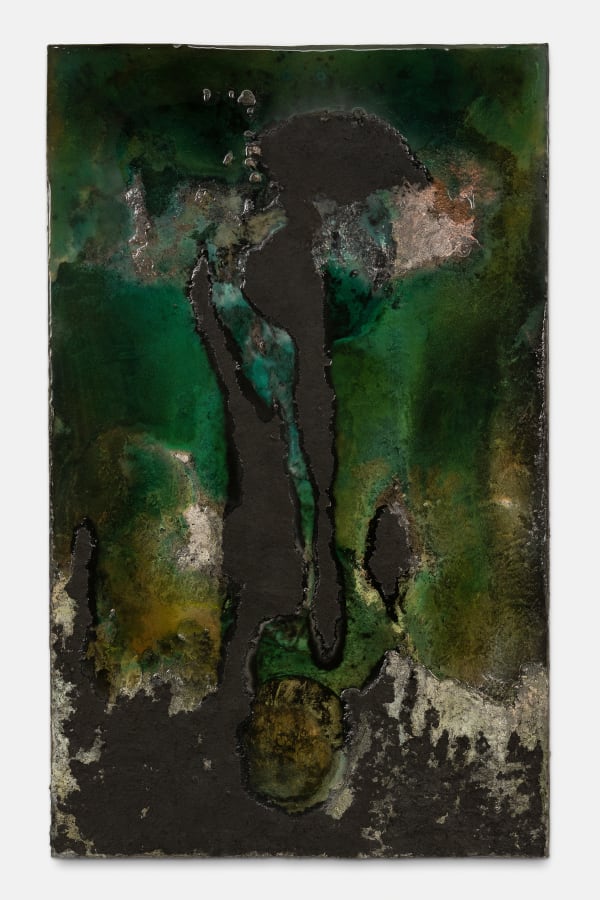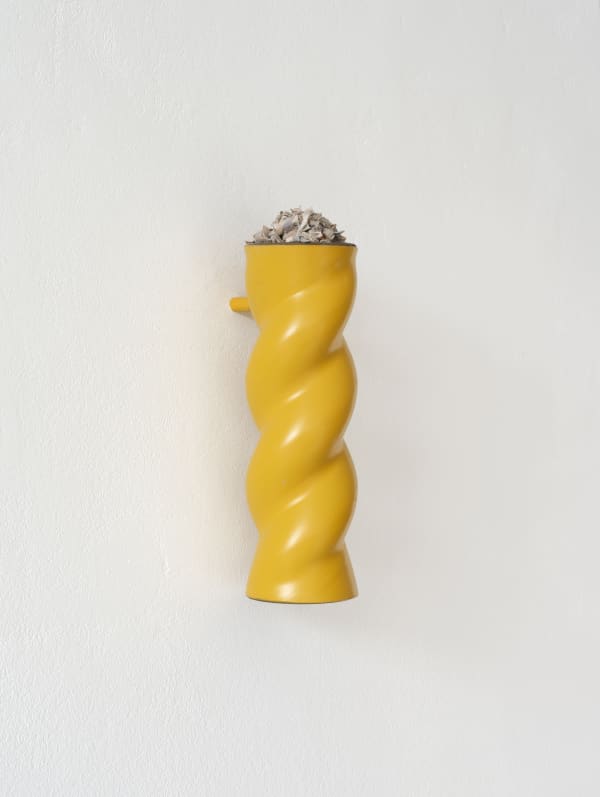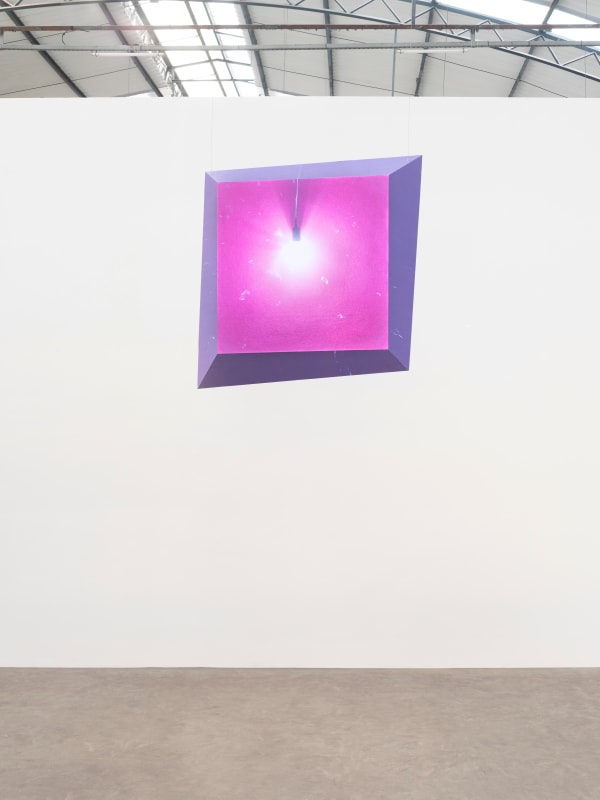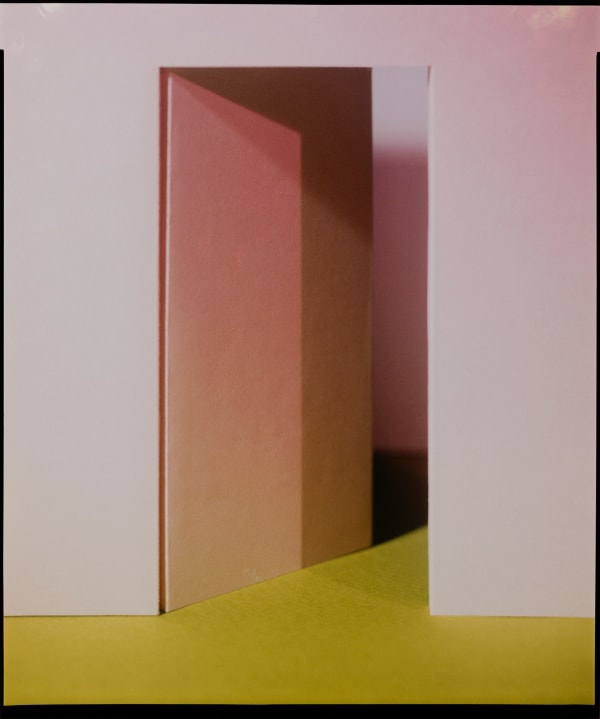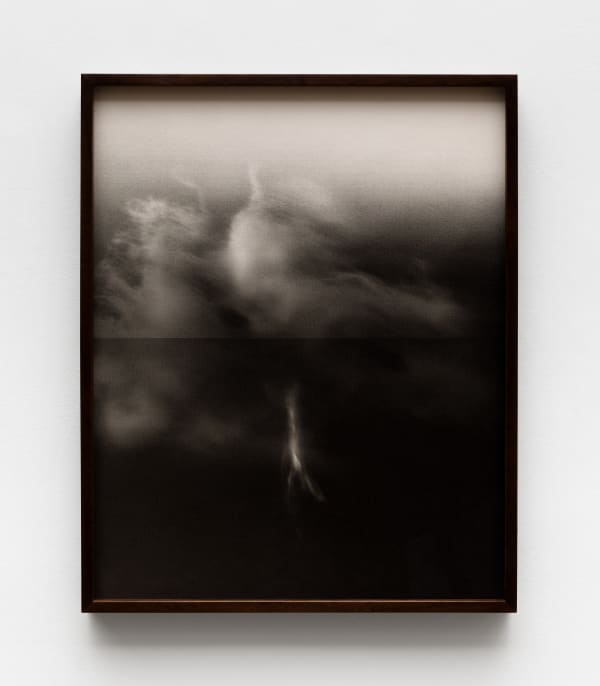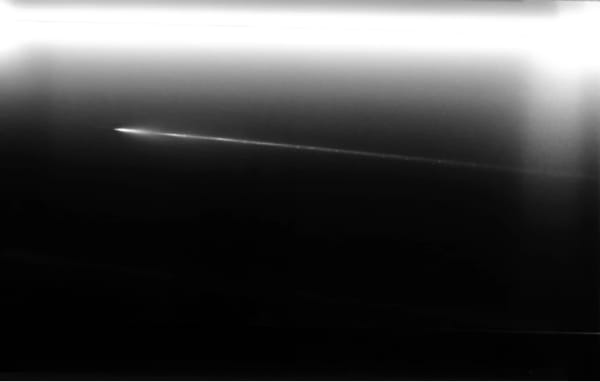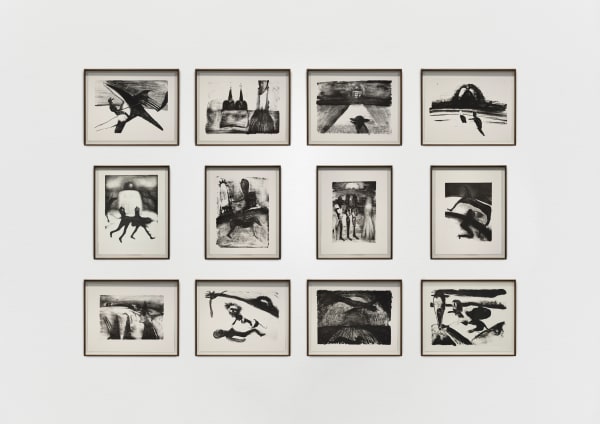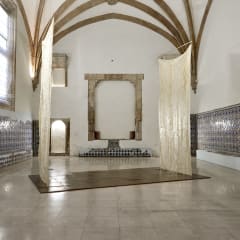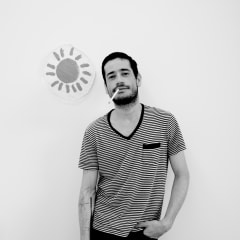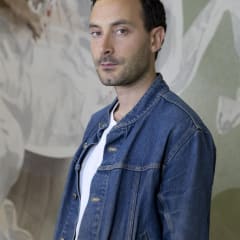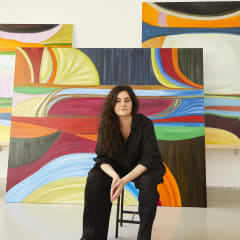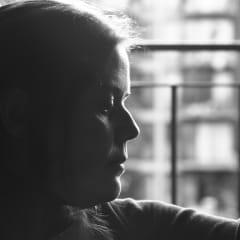Blinded by the Light Group exhibition
A Fortes D’Aloia & Gabriel e a Mendes Wood DM apresentam Blinded by the Light, uma exposição que convida à reflexão sobre os limiares onde a luz e a sombra se encontram, a nitidez se dissolve e a cor se esvai. Esses elementos em constante transformação embaralham o olhar, ao transitar por aquilo que não é inteiramente visível nem completamente oculto. Nesse espaço liminar, luz e escuridão são aliadas, e não opostas, na formação da arquitetura física e emocional da vida. Ser ofuscada pela luz é ser lembrada da fragilidade do ato de ver, um gesto que nunca é neutro nem definitivo. Em um mundo moldado pela instabilidade política e colapso ambiental, ato de ver carrega um peso ainda maior, reflexões à meia-luz.
A prática de Laís Amaral está ancorada em um espaço que articula memória, percepção e luto ecológico. Usando ferramentas de pintura não convencionais, trabalhos como Sem título III (série Fecho os olhos, vejo a mata) (2025), evocam as marcas deixadas pelo extrativismo nas paisagens brasileiras, exuberantes, porém feridas. Em diálogo com a ruptura de Amaral com as tradições canônicas da pintura, Antonio Tarsis emprega materiais cotidianos como palitos de fósforo, embalagens e resíduos urbanos. Tarsis constrói cenas moldadas tanto pela presença quanto pela ausência: em Sem título (Desert Landscapes) (2025), um terreno árido vira símbolo silencioso de resiliência e memória — o deserto serve como metáfora central da resistência, da perda e da renovação.
A prática de Erika Verzutti se dá na intersecção entre escultura e pintura, forma natural e modernismo. Beach with three suns and rain (2024) joga com a perspectiva, posicionando o espectador como um pássaro que sobrevoa uma praia. Construída a partir de materiais naturais, essa paisagem familiar e fictícia evoca a fragilidade ecológica e se torna metáfora para a memória e a transformação, refletindo a tensão poética entre permanência e desaparecimento. Nina Canell e Rodrigo Cass também exploram a natureza orgânica dos materiais. Os processos de Canell resistem à estabilidade, permitindo que substâncias se modifiquem conforme as condições atmosféricas, marcando o tempo e o trabalho silencioso da natureza — como em Moody (2024), onde esferas de para-raios capturam o impacto violento da luz sobre a matéria. As obras de ambos revelam a transformação como um fio condutor: os materiais marcados pelo clima de Canell refletem nosso consumo desenfreado de recursos, enquanto as composições texturais de Cass mapeiam os limites onde o trabalho encontra o mundo material.
Em Papa Tonnerre’s Tales (2025), de Pol Taburet, a ausência deliberada de cor se torna uma linguagem: em preto e branco, as composições narram como o guardião da memória de uma comunidade se transforma em traidor em mitos crioulos, com criaturas que deslizam da luz espiritual à sombra. Enquanto isso, as formas abstratas de Paloma Bosquêresistem a interpretações narrativas; ela explora a profundidade da matéria escura para ser sentida, e não apenas vista. Placa (2025) nos convida a olhar além do visível e adentrar o atmosférico.
A atmosfera em si é o campo de investigação de Leticia Ramos: por meio da fotografia analógica e do cinema experimental, ela constrói paisagens ficcionais ancoradas na imaginação científica. Dispositivos feitos à mão capturam não só imagens, mas também luas em movimento, montanhas e formações geológicas em transformação; ficção e não ficção se confundem, e as paisagens se revelam como terrenos especulativos moldados pela luz e pelo tempo. A série fotográfica de Mauro Restiffe atenta para interações do dia a dia moldadas pela iluminação, capturando a vida cotidiana através de contrastes luminosos, tornando inesperadas certas cenas comuns. Ramos e Restiffe encontram ressonância nas transformações fílmicas e fotográficas de João Maria Gusmão, onde a luz é tanto sujeito quanto meio: materiais sobrepostos e translúcidos reimaginam formas familiares com sutileza, enquanto Maaike Schoorel evoca momentos fantasmagóricos a partir de registros do cotidiano, remetendo ao borrão da memória.
Na obra de Marina Perez Simão, a cor se torna movimento: pinceladas imitam o vento e a luz se dispersa pela tela em ritmos pulsantes, interrompendo e reconfigurando o olhar. As paisagens de Janaina Tschäpe se desdobram em metamorfoses contínuas; gestos amplos em óleo e pastel ecoam ciclos de crescimento e decomposição, transformando mundos naturais em contadores de histórias. Born to Love (2025) e Clareira (2025) revelam como Marina Rheingantz sobrepõe impressões, de forma que pequenos fragmentos de tinta se tornam inscrições climáticas, onde cada detalhe ecoa mudanças dramáticas.
Mountain and Sea (2018), de Matthew Lutz-Kinoy, marcado por uma gama de vermelhos — profundos e pálidos — atravessados pelo branco, e obras de Frank Walter que exaltam o mar, a lua, o sol e as árvores sempre mutáveis de sua terra natal, Antígua e Barbuda, oferecem paisagens onde a natureza ainda se manifesta e respira — onde a cor se torna atmosfera e a luz viaja com delicadeza, moldada por uma sensível atenção à presença espiritual da natureza.
Blinded by the Light nos lembra que esperança, cuidado, reparação e conexão com o mundo natural não são apenas possíveis, mas essenciais para imaginar novas formas de viver, perceber e estar junto.
– Cindy Sissokho
-
 Laís Amaral, Untitled III (Fecho os olhos, vejo a mata series) | Sem título III (série Fecho os olhos, vejo a mata), 2025
Laís Amaral, Untitled III (Fecho os olhos, vejo a mata series) | Sem título III (série Fecho os olhos, vejo a mata), 2025 -
 Paloma Bosquê, Plate | Placa, 2025
Paloma Bosquê, Plate | Placa, 2025 -
 Paloma Bosquê, Drawing / Desenho, 2022
Paloma Bosquê, Drawing / Desenho, 2022 -
 Nina Canell, Hardscapes (0,017 Tonnes), 2022
Nina Canell, Hardscapes (0,017 Tonnes), 2022 -
 Nina Canell, Hardscapes (0,023 Tonnes), 2022
Nina Canell, Hardscapes (0,023 Tonnes), 2022 -
 Nina Canell, Soft Corner (Visitation), 2016 - 2022
Nina Canell, Soft Corner (Visitation), 2016 - 2022 -
 Nina Canell, Moody, 2024
Nina Canell, Moody, 2024 -
 Nina Canell, Polyethylene Irritants, 2018
Nina Canell, Polyethylene Irritants, 2018 -
 Nina Canell, Screee, 2022
Nina Canell, Screee, 2022 -
 Rodrigo Cass, O Amado / The Lover One, 2025
Rodrigo Cass, O Amado / The Lover One, 2025 -
 Rodrigo Cass, A Amada / The Beloved Woman, 2025
Rodrigo Cass, A Amada / The Beloved Woman, 2025 -
 Rodrigo Cass, Geometria sensível, 2023
Rodrigo Cass, Geometria sensível, 2023 -
 João Maria Gusmão, Window and full Moon, 2025
João Maria Gusmão, Window and full Moon, 2025 -
 João Maria Gusmão, Ceiling lamp off, 2025
João Maria Gusmão, Ceiling lamp off, 2025 -
 João Maria Gusmão, Pink room, 2025
João Maria Gusmão, Pink room, 2025 -
 João Maria Gusmão, Street lamp and building, 2025
João Maria Gusmão, Street lamp and building, 2025 -
 Matthew Lutz-Kinoy, Mountain and Sea, 2018
Matthew Lutz-Kinoy, Mountain and Sea, 2018 -
 Marina Perez Simão, Untitled | Sem Título, 2025
Marina Perez Simão, Untitled | Sem Título, 2025 -
 Leticia Ramos, THE BLUE NIGHT I, 2020
Leticia Ramos, THE BLUE NIGHT I, 2020 -
 Leticia Ramos, LUA E MONTANHA_01 (Patricia I), 2024
Leticia Ramos, LUA E MONTANHA_01 (Patricia I), 2024 -
 Leticia Ramos, Raio, 2024
Leticia Ramos, Raio, 2024 -
 Leticia Ramos, Magnetic Field, 2018
Leticia Ramos, Magnetic Field, 2018 -
 Mauro Restiffe, A maçã, 2020
Mauro Restiffe, A maçã, 2020 -
 Mauro Restiffe, Luz, 2021
Mauro Restiffe, Luz, 2021 -
 Mauro Restiffe, Brasa, 2019
Mauro Restiffe, Brasa, 2019 -
 Mauro Restiffe, Matheus ao sol, 2020
Mauro Restiffe, Matheus ao sol, 2020 -
 Mauro Restiffe, Charlie touching the light, 2019
Mauro Restiffe, Charlie touching the light, 2019 -
 Mauro Restiffe, João Maria, 2018
Mauro Restiffe, João Maria, 2018 -
 Mauro Restiffe, O Aquário, 2000
Mauro Restiffe, O Aquário, 2000 -
 Marina Rheingantz, Clareira, 2025
Marina Rheingantz, Clareira, 2025 -
 Marina Rheingantz, Born to Love, 2025
Marina Rheingantz, Born to Love, 2025 -
 Maaike Schoorel, Rugen Sunlight, 2019
Maaike Schoorel, Rugen Sunlight, 2019 -
 Maaike Schoorel, Water and Playground, 2024
Maaike Schoorel, Water and Playground, 2024 -
 Pol Taburet, Papa Tonnerre's Tales, 2025
Pol Taburet, Papa Tonnerre's Tales, 2025 -
 Pol Taburet, Gun, 2025
Pol Taburet, Gun, 2025 -
 Janaina Tschäpe, Suspiro cor de rosa, 2025
Janaina Tschäpe, Suspiro cor de rosa, 2025 -
 Erika Verzutti, Beach with three suns and rain, 2024
Erika Verzutti, Beach with three suns and rain, 2024


